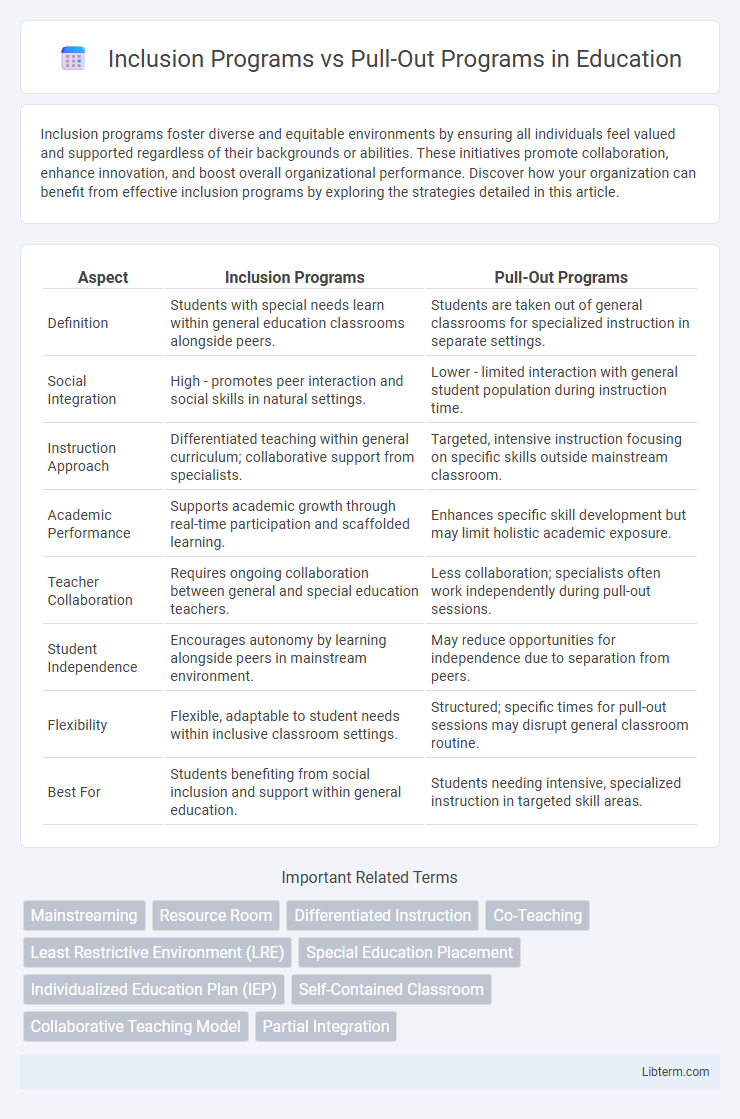Inclusion programs foster diverse and equitable environments by ensuring all individuals feel valued and supported regardless of their backgrounds or abilities. These initiatives promote collaboration, enhance innovation, and boost overall organizational performance. Discover how your organization can benefit from effective inclusion programs by exploring the strategies detailed in this article.
Table of Comparison
| Aspect | Inclusion Programs | Pull-Out Programs |
|---|---|---|
| Definition | Students with special needs learn within general education classrooms alongside peers. | Students are taken out of general classrooms for specialized instruction in separate settings. |
| Social Integration | High - promotes peer interaction and social skills in natural settings. | Lower - limited interaction with general student population during instruction time. |
| Instruction Approach | Differentiated teaching within general curriculum; collaborative support from specialists. | Targeted, intensive instruction focusing on specific skills outside mainstream classroom. |
| Academic Performance | Supports academic growth through real-time participation and scaffolded learning. | Enhances specific skill development but may limit holistic academic exposure. |
| Teacher Collaboration | Requires ongoing collaboration between general and special education teachers. | Less collaboration; specialists often work independently during pull-out sessions. |
| Student Independence | Encourages autonomy by learning alongside peers in mainstream environment. | May reduce opportunities for independence due to separation from peers. |
| Flexibility | Flexible, adaptable to student needs within inclusive classroom settings. | Structured; specific times for pull-out sessions may disrupt general classroom routine. |
| Best For | Students benefiting from social inclusion and support within general education. | Students needing intensive, specialized instruction in targeted skill areas. |
Overview of Inclusion and Pull-Out Programs
Inclusion programs integrate students with disabilities into general education classrooms, promoting social interaction and access to the standard curriculum alongside their peers. Pull-out programs provide specialized instruction outside the general classroom, targeting specific skill deficits in a more focused setting. Both approaches aim to support individual learning needs but differ in their delivery and level of integration within the school environment.
Defining Inclusion Programs in Education
Inclusion programs in education integrate students with disabilities into mainstream classrooms, providing tailored support to meet diverse learning needs within a shared environment. These programs emphasize collaboration among educators, specialists, and peers to foster an inclusive culture that promotes social interaction and academic growth. Inclusion ensures equitable access to curriculum by adapting instructional strategies and resources, benefiting all students through a dynamic and supportive educational setting.
Understanding Pull-Out Programs: Key Features
Pull-out programs involve temporarily removing students from their general education classrooms to provide specialized instruction in areas such as speech therapy or special education. These programs focus on individualized support tailored to address specific learning challenges while maintaining communication with the mainstream classroom. Key features include targeted interventions, smaller group settings, and collaboration between pull-out instructors and general educators to monitor student progress.
Advantages of Inclusion Programs
Inclusion programs foster a collaborative learning environment by integrating students with special needs into general education classrooms, promoting social interaction and reducing stigma. These programs enhance academic outcomes through differentiated instruction tailored to diverse learning styles and abilities. Teachers in inclusion settings benefit from professional development and team teaching, resulting in a more supportive and adaptive educational experience for all students.
Benefits of Pull-Out Programs for Students
Pull-out programs provide individualized support tailored to students' specific learning needs, enhancing academic outcomes through targeted instruction. These programs offer a distraction-free environment, allowing educators to address skill gaps with personalized interventions. Pull-out services also foster increased student confidence by focusing on strengths and addressing weaknesses without the pressure of the mainstream classroom setting.
Challenges Faced by Inclusion Programs
Inclusion programs often face challenges such as limited resources, insufficient teacher training, and balancing diverse student needs within a single classroom setting. Educators may struggle with providing adequate support to students with disabilities while managing the pace and curriculum for all learners. These challenges can impact the effectiveness of inclusive education compared to pull-out programs, where specialized instruction occurs separately.
Drawbacks of Pull-Out Programs
Pull-out programs often isolate students from their peers, limiting social interaction and inclusion in the general education environment. These programs may cause students to miss essential classroom instruction, leading to gaps in academic progress and increased stigmatization. Reduced collaboration between special education teachers and general educators can hinder the development of cohesive individualized education plans (IEPs).
Comparing Academic Outcomes: Inclusion vs Pull-Out
Inclusion programs integrate students with disabilities into general education classrooms, fostering social interaction and continuous access to grade-level curriculum, which often results in improved academic outcomes and higher engagement. Pull-out programs remove students from the general classroom for specialized instruction, which can provide targeted skill-building but may limit exposure to the full curriculum and peer learning opportunities. Studies indicate that inclusion programs generally support better academic performance and social development compared to pull-out models, especially when adequate support services and teacher training are in place.
Social and Emotional Impacts on Students
Inclusion programs promote positive social interactions and foster a sense of belonging by integrating students with diverse abilities into general education classrooms, enhancing emotional well-being and self-esteem. Pull-out programs, while providing targeted academic support, may lead to feelings of isolation or stigma as students are separated from their peers, potentially impacting social development and emotional security. Research indicates that inclusive settings contribute to improved peer relationships and reduced anxiety compared to pull-out interventions.
Best Practices for Program Implementation
Inclusion programs integrate students with diverse learning needs into general education classrooms, promoting social interaction and access to the core curriculum through differentiated instruction and collaborative teaching models. Pull-out programs provide specialized instruction outside the general classroom, emphasizing targeted skill development and individualized intervention plans delivered by specialists. Best practices for implementation involve ongoing professional development, data-driven decision-making, and active collaboration between general and special educators to ensure continuity and alignment with student goals.
Inclusion Programs Infographic

 libterm.com
libterm.com